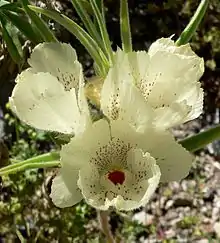| Mohavea | |
|---|---|
 | |
| Mohavea confertiflora | |
| Scientific classification | |
| Kingdom: | Plantae |
| Clade: | Tracheophytes |
| Clade: | Angiosperms |
| Clade: | Eudicots |
| Clade: | Asterids |
| Order: | Lamiales |
| Family: | Plantaginaceae |
| Tribe: | Antirrhineae |
| Genus: | Mohavea A.Gray |
| Species | |
Mohavea is a plant genus consisting of two species native to the deserts of the southwestern United States and northern Mexico. This genus is often included in the closely related snapdragon genus Antirrhinum.[1]
Taxonomy
Formerly included in the family Scrophulariaceae, the genus is now included in Plantaginaceae. The two species are both notable annuals flowering in the spring: the lesser mohavea, Mohavea breviflora, has small yellow flowers, while the ghost flower, Mohavea confertiflora, features large pale flowers with a pattern of purple spots.
Etymology
The genus name is derived from the Mojave River, where specimens were first collected by John C. Fremont.[2]
References
- ↑ Oyama, R. K.; Baum, D. A. (2004). "Phylogenetic relationships of North American Antirrhinum (Veronicaceae)". American Journal of Botany. 91 (6): 918–925. doi:10.3732/ajb.91.6.918. PMID 21653448.
- ↑ Jepson Manual Treatment
External links
This article is issued from Wikipedia. The text is licensed under Creative Commons - Attribution - Sharealike. Additional terms may apply for the media files.